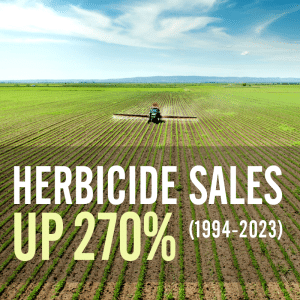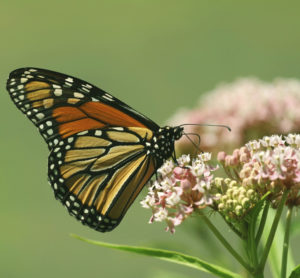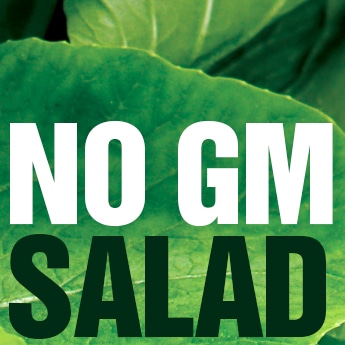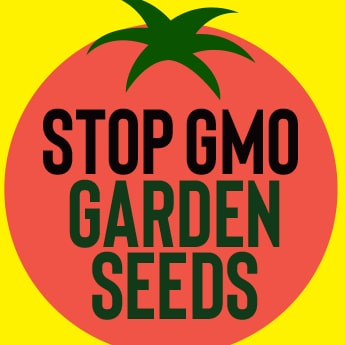Pesticides
The term “pesticides” includes herbicides, insecticides and fungicides.
The biotechnology industry promised that genetically modified (GM, also called genetically engineered) crops would reduce the use of pesticides in farming. Instead, herbicide use has increased with the use of GM crops. CBAN’s research found that herbicide sales in Canada have increased by 270% since GM crops have been introduced.
100% of the GM crops grown in Canada are herbicide-tolerant.
CBAN Factsheet: Genetically engineered crops have increased herbicide use, May 2024
Ecojustice Report: Toxic Harvest: Canada’s Pesticide Crisis, January 2025
Herbicide Sales Increased 270% (1994-2023)
Data from the Food and Agriculture Organisation of the UN (FAO) and subsequent Health Canada data shows that herbicide sales in Canada increased by 270% between 1994 and 2023 (latest data available as of July 2025). The first genetically engineered herbicide-tolerant crops were introduced in 1995.
Updates
December 2025: A highly cited study on the safety of Monsanto’s Roundup has been retracted. The paper was a key defense for safety claims. The study has been cited more than 700 times in scientific publications — including Health Canada’s 2017 re-evaluation of glyphosate use, which concluded that the chemical was “unlikely to pose a human cancer risk.”
- The retraction notice says, “Concerns were raised regarding the authorship of this paper, validity of the research findings in the context of misrepresentation of the contributions by the authors and the study sponsor and potential conflicts of interest of the authors.”
- Science journal retracts study on safety of Monsanto’s Roundup: ‘Serious ethical concerns’, Carey Gillam, The Guardian, December 5, 2025
- Decades-old study on common weed killer retracted after journal editor says Monsanto may have helped write it, Sarah Ritchie, The Canadian Press.
December 2025 – Press Release: Pesticides Coalition: Canada Must Choose Science and Health Over Lobbyists. A coalition of nearly 30 civil society and academic organizations, including CBAN, is urging the federal government to halt plans announced in the latest budget to weaken Canada’s pesticide process, and instead launch a long-overdue public debate and comprehensive reform. The groups are calling on the federal government to:
- Reform the pesticide assessment process to ensure it is based on marketed pesticide products, up to date independent scientific knowledge, and real life multiple exposures.
- Maintain periodic and ad-hoc reviews of active substances and pesticide products, including biocontrols, to respond quickly to emerging risks or harms, and to identify least-toxic approaches.
- Conduct a comprehensive review of the entire PCPA and its application, as required by the PCPA, and not just the re-evaluation provisions, with a view to improving the scientific approach of PMRA.
- Launch an expedited special review of glyphosate-based herbicides, under subsection 17(4) of the PCPA, including carcinogenicity, using up-to-date science and modern methodologies, and impose a moratorium on their renewals or registrations.
June 2025: A comprehensive, long-term carcinogenicity study on glyphosate has found that low doses cause multiple types of cancer in rats. Glyphosate alone and two commercial glyphosate-based formulations were administered to rats via drinking water before birth for 2 years. The Global Glyphosate Study was led by the Cesare Maltoni Cancer Research Center of the Ramazzini Institute in Italy. See the paper: Panzacchi S et al (2025). Carcinogenic effects of long-term exposure from prenatal life to glyphosate and glyphosate-based herbicides in Sprague–Dawley rats. Environmental Health volume 24, Article number: 36 (2025). https://ehjournal.biomedcentral.com/articles/10.1186/s12940-025-01187-2
May 2025: A new report from Friends of the Earth US refutes the widely held assumption that no-till agriculture automatically equals “regenerative”. No-till agriculture in both North and South America now overwhelmingly involves GM crops. Most no-till systems are so heavily dependent on herbicides to manage weeds that one-third of the US’s total annual pesticide use (includes herbicides, insecticides, and fungicides) can be attributed to no- and minimum-till genetically modified corn and soy production. No-till was steadily rising in the US before adoption of GM crops.
April 2025: The increased use of GM crops over the past 30 years has led to the expansion of agricultural land and increased use of the very pesticides these technologies are purported to curtail. Authors of the new study discuss GM crops and the Jevons paradox which describes how increased efficiency in the use of a resource can paradoxically increase rather than reduce its overall consumption: Flachs, A., Stone, G., Hallett, S. and Kranthi, K. . (2025), GM Crops and the Jevons Paradox: Induced Innovation, Systemic Effects and Net Pesticide Increases From Pesticide-Decreasing Crops. J Agrar Change e70006. https://doi.org/10.1111/joac.70006
March 2025: Bayer Crop Science has announced plans to introduce genetically engineered Vyconic soybeans, in 2027, with tolerance to five herbicides: dicamba, glufosinate, mesotrione, 2,4-D and glyphosate.
February 2025: The Federal Court has that found Health Canada’s 2022 decision to approve the glyphosate-based herbicide Mad Dog Plus was unreasonable and unsubstantiated by any scientific analysis. The Court set aside the renewal of the product, giving Health Canada six months to make a new decision on the renewal that transparently addresses new science on the risks. The court case was brought by Friends of the Earth Canada, Safe Food Matters, the David Suzuki Foundation, and Environmental Defence Canada,
February 2025: A study from researchers at the University of Nebraska Medical Center highlights that exposure to a mixture of agrichemicals might cause childhood cancer. Researchers observed a statistically significant positive association between the 32 agrichemicals and overall pediatric cancer and subtypes. Dicamba, glyphosate, paraquat, quizalofop, triasulfuron, and tefluthrin largely contributed to the joint association. This is the first study to estimate the combined effects of multiple pesticides on all 11 types of pediatric cancers over 22 years.
January 2025: A new, large study in the United States has found that infants in areas where glyphosate use was common were born slightly earlier and underweight: “Our results suggest the introduction of GM seeds and glyphosate significantly reduced average birthweight and gestational length.” The study finds that infant birthweight dropped in US counties where more GM crops are grown and sprayed with glyphosate. By 2005, babies born in counties dominated by GM corn, soy, and cotton weighed on average about 30 grams less than those born in rural counties that mostly grow other kinds of crops on which glyphosate is not used. Babies were also born 1.5 days sooner in places where glyphosate was commonly sprayed. Low birthweight is an important predictor of health problems and the authors write that birthweight provides “a canary-in-a-coalmine-like indicator of glyphosate toxicity.” Read about the study in Science magazine: Common weed killer may be harming infants
April 2024: On April 1, 2024, Mexico has delayed its 2020 commitment to ban the toxic herbicide glyphosate (the active ingredient in Bayer’s Roundup in the USA and Faena in Mexico) by 2024. Mexico’s 2020 decree calls for a phase-out of use of both the herbicide glyphosate and genetically modified (GM or genetically engineered) corn for human consumption in Mexico. Click here for information and the unofficial translation from the US government.“…with the objective of achieving self-sufficiency and food sovereignty, our country must be oriented towards establishing a sustainable and culturally adequate agricultural production, through the use of agroecological practices and inputs that are safe for human health, the country’s biocultural diversity and the environment, as well as congruent with the agricultural traditions of Mexico.” For updates check www.cban.ca/trade
September 2022: Report from GeneWatch UK, Time for the end of GM/GE herbicide tolerant crops? : “We conclude that the cultivation of GM HT crops may be regarded as a temporary aberration, rather than the revolution originally proclaimed by the proponents of these crops. The growing failure of RoundUp Ready crops, due to the spread of glyphosate resistant (GR) weeds, provides an opportunity to phase out the use of RR crops and adopt new methods and technologies. The priority should be to reduce and replace the use of herbicides: not to replace RR crops with other herbicide–tolerant crops, whether or not these are GM crops or produced by different methods. It is particularly important that RR crops are not pushed into new countries which have so far avoided stepping onto the “transgenic treadmill”, in which farmers are locked in to paying for ever more expensive seeds and herbicides. In seeking to expand markets for RR crops into new countries, the industry is dumping a failed technology on them.” Read the full report or download the summary of the report.
April 2022: Canada’s Ministers of Health, Environment and Climate Change, and Agriculture and Agri-Food have launched a “transformation” of the Pesticide Management Regulatory Agency. The transformation will be built on 4 pillars of action: improved transparency; increased use of real-world data and independent advice; strengthened human health and environmental protection through modernized pesticide business processes; and targeted review of the Pest Control Products Act.
Call to Re-think Genetically Engineered Herbicide-Tolerant Crops
August 2019: The Canadian Biotechnology Action Network (CBAN) and Prevent Cancer Now (PCN) are calling for a review of the use of genetically engineered (genetically modified or GM) herbicide-tolerant crops in Canada, in response to Monsanto’s request for government approval of GM corn MON 87429 that can withstand applications of four herbicides, including 2,4-D and dicamba.
- Click here to read the press release: “Call to Re-think Genetically Engineered Herbicide-Tolerant Crops: Proposed Monsanto corn tolerates four herbicides”, CBAN and Prevent Cancer Now, August 22, 2019.
- Click here to read the comments on MON 87429 submitted to the Canadian Food Inspection Agency by CBAN and PCN.
- Click here for more information on 2,4-D- and dicamba-tolerant crops.
Glyphosate is a “probable human carcinogen”
In 2015, the International Agency for Cancer Research (IARC) of the World Health Organization (WHO) concluded that:
- Glyphosate, the world’s most-used chemical ingredient for weed control, is a “probable human carcinogen” (March 2015)
- 2,4-D, the second most-used herbicide in Canada, is a “possible human carcinogen” (June 2015)
Other Updates
- December 2019: Bøhn, Thomas, and Erik Millstone. 2019. “The Introduction of Thousands of Tonnes of Glyphosate in the food Chain—An Evaluation of Glyphosate Tolerant Soybeans” Foods 8, no. 12: 669. Official statistics show that the rates of glyphosate use in Argentina and Brazil, two of the dominant countries for soy production, have increased significantly from 1996 to 2014 with an almost perfect linear fit. The farmer rates are more than twice as high as the recommended doses used in most field trials. This follows a 2017 paper Use of genetically modified crops and pesticides in Brazil: growing hazards which found the adoption of GM crops led to an increase in pesticide use in Brazil.
- May 23, 2019: CBAN Newsletter “In-Depth Update: Glyphosate and Other Pesticides, and Genetically Engineered Crops” for a roundup of the many latest developments.
- March 2019: The CBC documentary “The Monsanto Papers: The Canadian Connection”. CBC reports that Monsanto hired the Canadian company Intertek to coordinate four “independent expert panels” to publish papers concluding that glyphosate is not a carcinogen. In defending its decision to re-approve glyphosate, Health Canada cited those papers in its list of references. This and more in the documentary.
- October 2017: You can watch video of testimony at the European Parliament explaining the contents of internal emails dubbed the “Monsanto Papers” released by court order in the US.
- April 2017: The Canadian Food Inspection Agency (CFIA) published the results of its testing of foods for glyphosate residues (2015-2016) The CFIA tested 3,188 food samples for the herbicide glyphosate. Glyphosate was found in 29.7% of samples. Glyphosate residues above MRLs were found in 1.3% of samples. (The majority of GM crops are genetically modified to be glyphosate-tolerant.)
- April 2017: CBAN submitted comments to the Pesticide Management Regulatory Agency on the Cumulative Risk Assessment Framework, to raise the need to assess the impacts of GM herbicide-tolerant crops on herbicide use/exposure. Click here to read the comments from CBAN.
- April 2017: Article – Big Agro on Campus: Universities claim industry-funded research on chemical and pesticide safety is scientifically sound. Not everybody is convinced, The Walrus.
- October 2016: A review (monograph) on glyphosate from Pesticide Action Network International
- August 2015: An article in the New England Journal of Medicine argues that assessment of genetically modified food safety should also be tied to assessing the human health risks of the herbicides applied to GM crops. “We believe that the time has therefore come to thoroughly reconsider all aspects of the safety of plant biotechnology…The National Toxicology Program should urgently assess the toxicology of pure glyphosate, formulated glyphosate, and mixtures of glyphosate and other herbicides.”
Background
The United Nations Food and Agriculture Organization (FAO) reports that 21.9 million kilograms of herbicides were sold in Canada in 1994. Health Canada’s annual reports show that this number has steadily increased since then, and by 2017, had increased by 243%.
Glyphosate is the top pesticide ingredient sold in Canada. It is also the top agricultural herbicide ingredient, followed by glufosinate ammonium, MCPA and 2,4-D. Glyphosate use in Canada tripled between 2005 and 2011, climbing from 30.2 million litres to 89.7 million in Western Canada, and from 3.8 million litres to 12.3 million in Eastern Canada.
The widespread cultivation of GM glyphosate-tolerant crops, in particular, has driven up the use of glyphosate-based herbicides. Globally, glyphosate use has increased 15-fold since GM herbicide-tolerant crops were introduced, and 56% of glyphosate use is on herbicide-tolerant crops.
This increased use of glyphosate has resulted in the emergence and spread of glyphosate-resistant weeds. In response, biotechnology companies have genetically engineered crops to be tolerant to the older herbicides 2,4-D and dicamba. These GM crops will further increase the herbicide load in the environment and lead to even more herbicide-resistant weeds.
GM insect-resistant (Bt) crops have reduced insecticide use in some countries. The Canadian government has not monitored the impact of Bt crops on insecticide use in Canada. However, insects are beginning to develop resistance to Bt crops in the US and other countries, and farmers are turning to other insecticide applications to control them. Additionally, Bt plants themselves produce insecticidal toxins that are released into the environment.
The use of herbicides with herbicide-tolerant crops reduces weed diversity in and around fields, which in turn reduces habitat and food for other important species, including the Monarch butterfly (see below). Studies have also observed that GM insect-resistant crops can also have negative impacts on non-target insects, including pollinators, and soil and water organisms.
- For details see “Are GM Crops Better for the Environment?” CBAN’s second report in our GMO Inquiry.
- For an introduction to the herbicide glyphosate see the National Farmer’s Union: Glyphosate – Frequently Asked Questions.
From Pesticides and Our Health, Greenpeace, 2015:
Synthetic pesticides have been widely used in industrial agriculture throughout the world since the 1950s. Over time, many of these chemicals have become extremely pervasive in our environment as a result of their widespread repeated use and, in some cases, their environmental persistence. Some take an extremely long time to degrade, such that even those banned decades ago, including DDT and its secondary products, are routinely found in the environment today.
As a consequence of this persistence, and potential hazards to wildlife, effect-related research on the impact of pesticides has increased exponentially over the past 30 years. It is now clear that these effects are wide and varied. Over the same period, scientific understanding of the effects of pesticides on human health and their mechanisms of action has also expanded rapidly, with studies revealing statistical associations between pesticide exposure and enhanced risks of developmental impairments, neurological and immune disorders and some cancers.
Nevertheless, proving definitively that exposure to a particular pesticide causes a disease or other condition in humans presents a considerable challenge. There are no groups in the human population that are completely unexposed to pesticides, and most diseases are multi-causal giving considerable complexity to public health assessments. Furthermore, most people are exposed to complex and ever changing mixtures of chemicals, not just pesticides, in their daily lives, through multiple routes of exposure. Pesticides contribute further to this toxic burden.
Glyphosate
Glyphosate is the top pesticide ingredient sold in Canada. It is also the top agricultural herbicide ingredient, followed by glufosinate ammonium, MCPA and 2,4-D. There are over 169 registered pest control products containing glyphosate in Canada, authorized for various agricultural and non-agricultural uses (2025).
The widespread cultivation of GM glyphosate-tolerant crops, in particular, has driven up the use of glyphosate-based herbicides. Globally, glyphosate use has increased 15-fold since GM herbicide-tolerant crops were introduced, and 56% of glyphosate use is on herbicide-tolerant crops. Glyphosate use in Canada tripled between 2005 and 2011, climbing from 30.2 million litres to 89.7 million in Western Canada, and from 3.8 million litres to 12.3 million in Eastern Canada.
This increased use of glyphosate has resulted in the emergence and spread of glyphosate-resistant weeds. In response, biotechnology companies have genetically engineered crops to be tolerant to the older herbicides 2,4-D and dicamba. These GM crops will further increase the herbicide load in the environment and lead to even more herbicide-resistant weeds.
In 2015, the International Agency for Cancer Research (IARC) of the World Health Organization (WHO) concluded that glyphosate is a “probable human carcinogen”. In 2025, a comprehensive, long-term carcinogenicity study on glyphosate has found that low doses of cause multiple types of cancer in rats. The authors state that, “These results provide robust evidence supporting IARC’s conclusion that there is “sufficient evidence of carcinogenicity [of glyphosate] in experimental animals”. Furthermore, our data areconsistent with epidemiological evidence on the carcinogenicity of glyphosate and glyphosate-based herbicides.” (Panzacchi S et al, 2025).
Between 2004 and 2017, the Pest Management Regulatory Agency (PMRA) of Health Canada conducted a re-evaluation of glyphosate’s health and environmental risks. The Agency completed its analysis in 2015 and issued a proposed re-evaluation decision for public consultation on April 13, 2015. Following this consultation, the PMRA issued its final re-evaluation decision in 2017, concluding that glyphosate posed acceptable health and environmental risks and, contrary to the IARC’s findings, was not carcinogenic. This decision allowed the continued registration of glyphosate products in Canada.
National Observer, May 16, 2024: ‘To say nothing is not public service’: former Agriculture Canada official raised red flags on pesticide. A former official in Canada’s agriculture ministry, David Cox, accused the federal pesticide regulator of failing to assess the health risks posed by the controversial herbicide glyphosate months before leaving the ministry: “For your sakes, please take this seriously if you haven’t yet. Never been clear to me if these [concerns] are dismissed because of the policy paradigm driving the biotechnology agenda … or that I am seen as an organic arguer defaming [glyphosate]. I am just revealing context based on evidence I get from various sources.”
Glyphosate use and the Monarch butterfly
“Milkweed decline is strongly correlated to with the use of herbicide-resistant crops.”
– COSEWIC Assessment and Status Report on the Monarch (Danaus plexippus) in Canada, 2016
 December 2024: The US Fish and Wildlife Service is proposing to list the Monarch butterfly as endangered and says “Threats to monarchs include loss and degradation of breeding, migratory and overwintering habitat; exposure to insecticides; and the effects of climate change.”
December 2024: The US Fish and Wildlife Service is proposing to list the Monarch butterfly as endangered and says “Threats to monarchs include loss and degradation of breeding, migratory and overwintering habitat; exposure to insecticides; and the effects of climate change.”
As of December 2023, the Monarch butterfly is classified as an endangered species in Canada. In the species registry, the Government of Canada summarizes the threats including: “The increased use of herbicides and subsequent decline in milkweeds is a significant threat facing Monarchs throughout their North American range. Increased herbicide use may also cause declines in nectar supplies needed by migrating Monarchs and reduce overwinter survival. Neonicotinoid pesticides are an emerging threat, the magnitude of which is poorly understood.” The government conducted an assessment of the economic impacts of classifying the butterfly as endangered.
- CBAN’s comments to Environment and Climate Change Canada in support of the classification.
- The Committee on the Status of Endangered Wildlife in Canada (COSEWIC) recommended the reclassification.
Court Cases
February 2025: The Federal Court has that found Health Canada’s 2022 decision to approve the glyphosate-based herbicide Mad Dog Plus was unreasonable and unsubstantiated by any scientific analysis. The Court set aside the renewal of the product, giving Health Canada six months to make a new decision on the renewal that transparently addresses new science on the risks. Environmental and health groups had argued that the Pest Management Regulatory Agency (PMRA) of Health Canada failed to conduct a rigorous, up-to-date scientific assessment of glyphosate before allowing the renewal of the glyphosate-based herbicide called “Mad Dog Plus”, which is used in both agriculture and forestry. New science on the harms of glyphosate has emerged since Health Canada last re-evaluated the health and environmental risks of glyphosate in 2017. The court case was brought forward by Friends of the Earth Canada, Safe Food Matters, the David Suzuki Foundation, and Environmental Defence Canada, represented by Ecojustice lawyers.
Three court cases in the US have found Monsanto liable for the cancer risk of its glyphosate-based herbicides. Court documents show:
- Monsanto never conducted epidemiology studies to evaluate the cancer risks for users of Roundup and its other glyphosate-based herbicide formulations.
- Monsanto was aware that the surfactants in Roundup were much more toxic than glyphosate alone.
- Monsanto financing ghostwritten studies and articles aimed at discrediting independent scientists whose work found dangers with Monsanto’s herbicides.
- When the US Agency for Toxic Substances and Disease Registry sought to evaluate glyphosate toxicity in 2015, Monsanto engaged the assistance of EPA officials to delay the review.
- Monsanto enjoyed a close relationship with certain officials within the Environmental Protection Agency (EPA), who have repeatedly backed Monsanto’s assertions about the safety of its glyphosate products.
- The company internally had worker safety recommendations that called for wearing a full range of protective gear when applying glyphosate herbicides, but did not warn the public to do the same.
For details and updates, follow the Monsanto Roundup Trial Tracker from U.S. RIght to Know
Canada: Farmer Launches Class Action
May 2019: A Saskatchewan farmer in his late 50s who is diagnosed with non-Hodgkin’s lymphoma is leading a class action lawsuit against Bayer and Monsanto, contending that exposure to Roundup herbicide contributed to his cancer and that of others, and that Monsanto (now Bayer) withheld information about the safety of its herbicide. “Sask. farmer leads class action glyphosate lawsuit“, The Western Producer, May 15, 2019
Court Case: Pilliod v. Monsanto
May 2019: A California jury ordered Monsanto to pay just over $2 billion in punitive and compensatory damages to a married couple who both developed non-Hodgkin lymphoma they say was caused by their many years of using Roundup products. The ruling includes punitive damages, which means the jury found that Monsanto “engaged in conduct with malice, oppression or fraud committed by one or more officers, directors or managing agents of Monsanto” who were acting on behalf of the company.
Court Case: Dewayne Johnson v. Monsanto Company
 “This case is way bigger than me. I hope it gets the attention that it needs.”
“This case is way bigger than me. I hope it gets the attention that it needs.”
– Dewayne Johnson, former school groundskeeper awarded $78 million from Monsanto
Watch the documentary Into the Weeds. Stream a shorter version on CBC Gem.
November 2018: A judge has cut the $289 award to Dewayne “Lee” Johnson down to $78 million. However, the judge did not overturn the decision (see below) as she indicated she might, after jurors in the initial case wrote to defend their ruling and process.
August 2018: A California jury reached a verdict in a personal liability lawsuit against Monsanto, in the case of Dewayne Johnson, finding that Monsanto’s glyphosate product, Roundup, caused a school groundskeeper’s terminal non-Hodgkin lymphoma. The jury not only found that Roundup caused the plaintiff’s cancer, awarding him $39.3 million in pain and suffering and economic damages, but also that Monsanto acted “with malice or oppression” and awarded an additional $250 million in punitive damages. Read the article in The Guardian “One Man’s Suffering Exposed Monsanto’s Secrets to the World” by Carey Gillam.
Resources
Pesticides and GM Crops
- Genetically engineered crops have increased herbicide use CBAN Factsheet, May 2024
- Time for the end of GM/GE herbicide tolerant crops? Report, GeneWatch UK, September 2022
- Gene-Silencing Pesticides: Risks and Concerns – Report and Briefing, Friends of the Earth USA, October 2020
- Click here for more information from CBAN on 2,4-D- and dicamba-tolerant crops
- “Are GM Crops Better for the Environment?” – CBAN Report, 2015, CBAN’s second report in the GMO Inquiry documents the rise in herbicide sales with genetically modified crops in Canada and examines the environmental impacts.
- “What next after a ban on glyphosate—more toxic chemicals and GM crops? Or the transformation of global food systems?” The African Centre for Biodiversity (ACB), the Network for a GE Free Latin America (RALLT) and the Third World Network. June 2015. A number of countries have already taken action to reduce or halt the use of glyphosate in response to the IARC assessment. While glyphosate is still in use and is heavily relied upon for GM soy production in particular, Monsanto and other biotechnology and agro-chemical companies are already planning for business after glyphosate. A plethora of GM crops that are tolerant to multiple toxic herbicides – including 2,4-D and dicamba – are already approved for the market, while Monsanto has recently sought the potential acquisition of Syngenta, the world’s largest producer of herbicides.
Pesticides and Pollinators
A 2020 study from the US found that milkweed plants, which are the main source of food for Monarch butterflies, were contaminated with 64 types of pesticide residues. Monarch butterfly populations have shrunk to 1% of their numbers in the last 3 decades. “We expected to find some pesticides in these plants, but we were rather surprised by the depth and extent of the contamination,” said Matt Forister, a butterfly expert, biology professor at the University of Nevada, Reno and co-author of the paper. “From roadsides, from yards, from wildlife refuges, even from plants bought at stores – doesn’t matter from where – it’s all loaded with chemicals. We have previously suggested that pesticides are involved in the decline of low elevation butterflies in California, but the ubiquity and diversity of pesticides we found in these milkweeds was a surprise.”
found that milkweed plants, which are the main source of food for Monarch butterflies, were contaminated with 64 types of pesticide residues. Monarch butterfly populations have shrunk to 1% of their numbers in the last 3 decades. “We expected to find some pesticides in these plants, but we were rather surprised by the depth and extent of the contamination,” said Matt Forister, a butterfly expert, biology professor at the University of Nevada, Reno and co-author of the paper. “From roadsides, from yards, from wildlife refuges, even from plants bought at stores – doesn’t matter from where – it’s all loaded with chemicals. We have previously suggested that pesticides are involved in the decline of low elevation butterflies in California, but the ubiquity and diversity of pesticides we found in these milkweeds was a surprise.”
In 2015, a report from the Center for Food Safety found that spraying of glyphosate on genetically engineered crops in the US had greatly reduced milkweed populations in and near farm fields. The loss of this vital habitat and food source had, in turn, decimated the population of the Monarch butterfly.
Pollinators are also affected by other pesticides, such as neonicotinoids. A 2015 factsheet, the Hidden Costs of Toxic Seed Coatings: Insecticide Use on the Rise, describes studies that found that a group of insecticides called neonicotinoids (abbreviated as “neonics”) are likely to be an important cause of declining pollinator populations and poor pollinator health. Neonics are the most widely used insecticides in the world, and have been repeatedly shown to have lethal and sub-lethal effects on beneficial insects.
Pesticide Toxicity
- Glyphosate and Cancer Risks: Frequently Asked Questions, Center for Food Safety, US, May 2015
- The world’s most used weed-killer is probably carcinogenic – so what? Meg Sears, Prevent Cancer Now, June 2015
- Pesticides and Our Health, Greenpeace International, May 2015
Other Resources
Synthetic pesticides are not permitted for use in organic food production. Here is more information on the organic standard in Canada.
Organizations with up-to-date information on pesticide toxicity and related issues:






